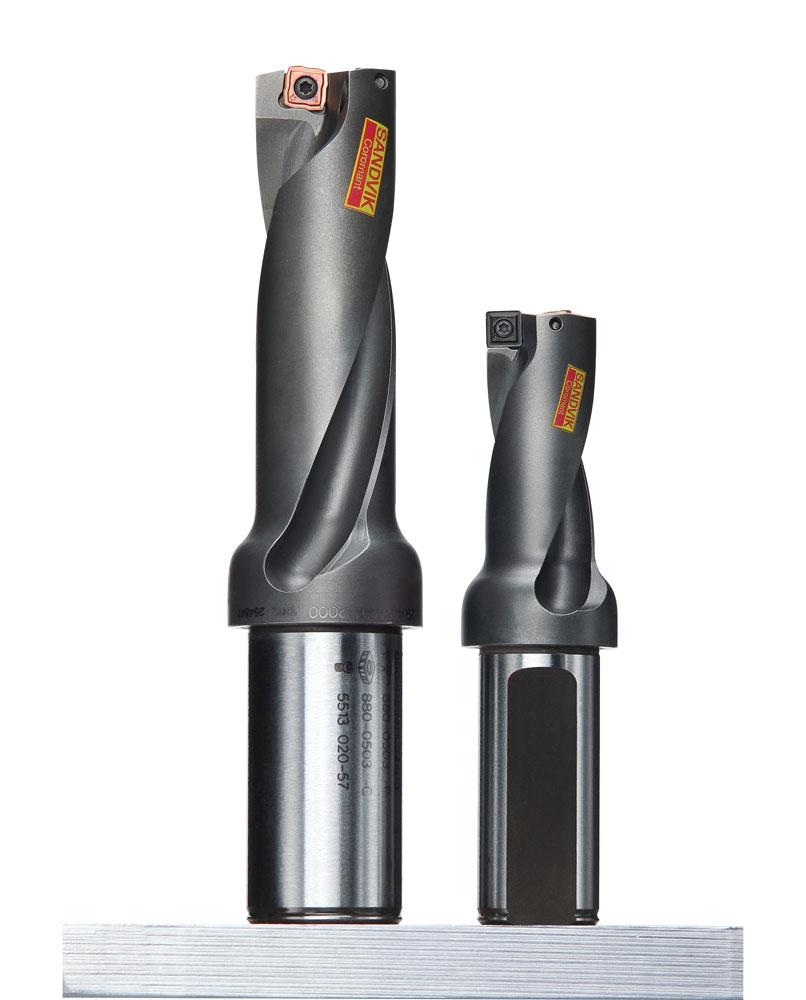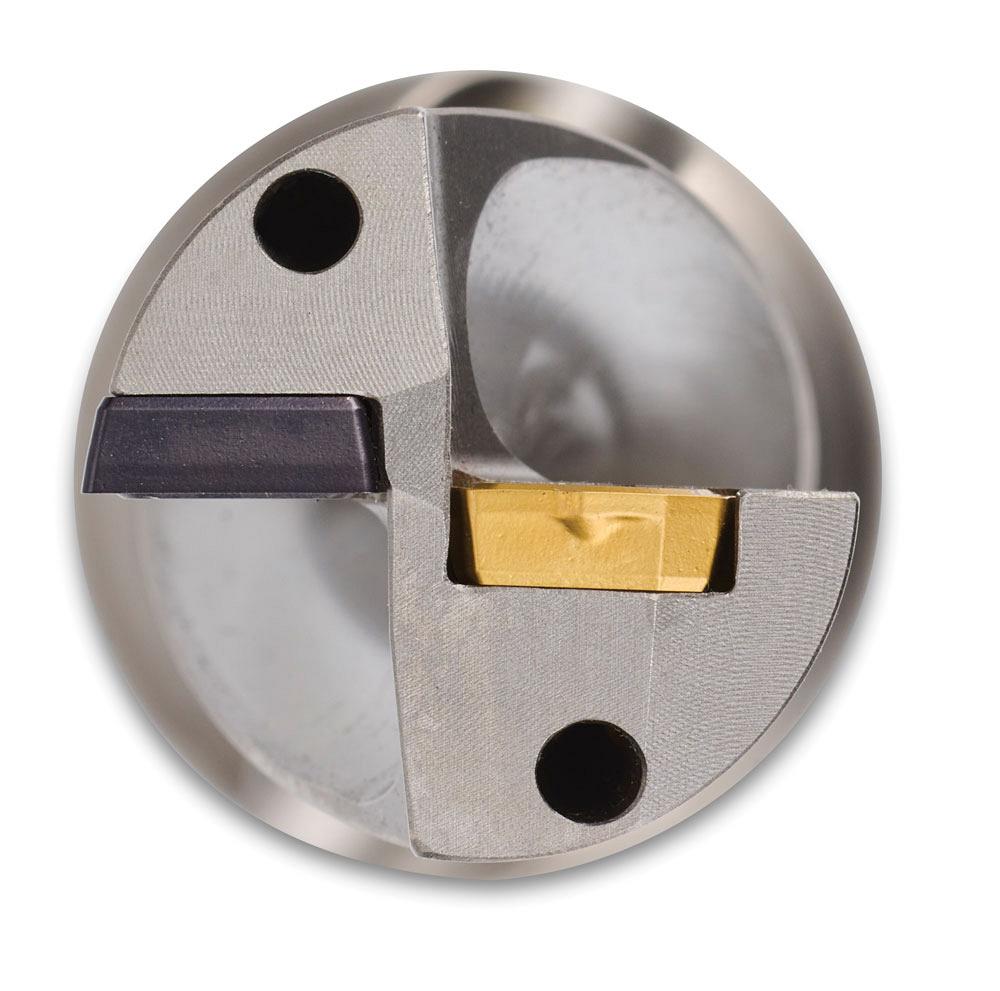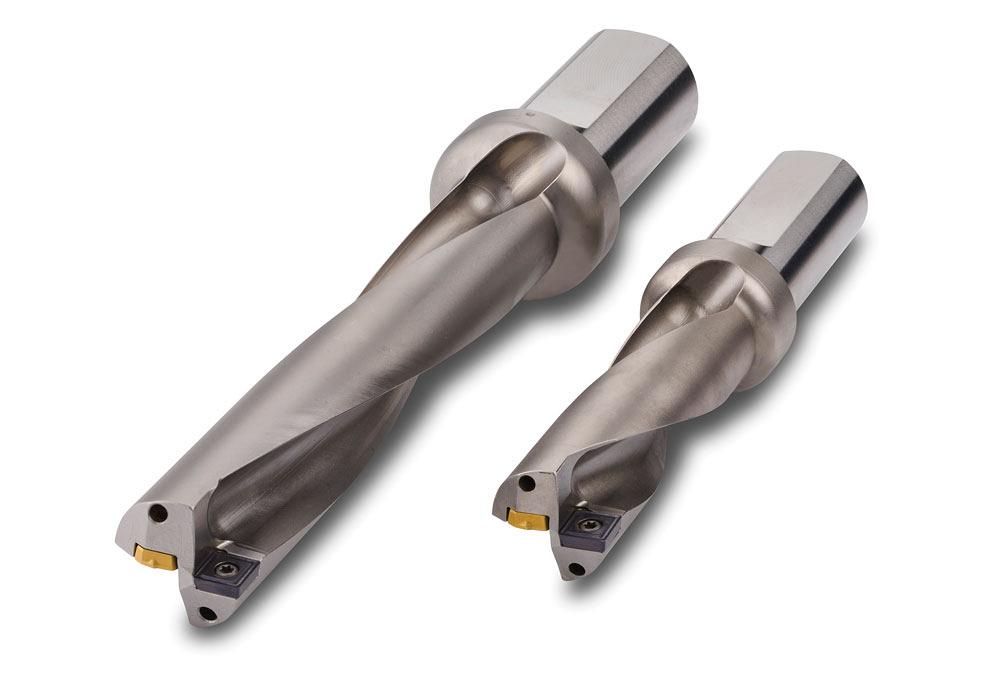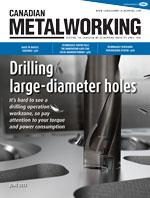Editor
- FMA
- The Fabricator
- FABTECH
- Canadian Metalworking
Drilling large-diameter holes
It’s hard to see a drilling operation’s workzone, so pay attention to your torque and power consumption
- By Joe Thompson
- July 10, 2023
- Article
- Cutting Tools

For hole diameters that exceed 2 in., indexable drills enable economical, productive machining. Sandvik Coromant
Drilling is a fast, economical, and productive way to produce holes.
However, if holes are large in diameter, say more than 2 in., solid-carbide drills become less economical, and, in certain cases, exchangeable-head drills are the same. These holes become the home of indexable inserts.
An indexable drill typically has two inserts and a hardened steel body. A central (or inner) insert and a peripheral (or outer) insert are used, and wipers often are standard features on the peripheral insert. Large-diameter drills can have more than two inserts. The number is chosen based on size of inserts, which need to provide the correct amount of overlap to be perfectly suited for the full diameter of the drill.
Depending on the operational requirements and the material being cut, these inserts can be the same size and shape but with different grades, or they can be two completely different inserts.
This mixing and matching of inserts enables machinists to really dial-in the tool for their application. It’s important to keep in mind, however, that if you use large-sized inserts you will produce large chips. Square- and triangle-shaped inserts are commonly used in combination because they interrupt the chips and break them into manageable pieces.
A simple way to think about hole creation outcomes starts with determining the best way to produce the hole diameter and depth you need with the quality that you desire.
Drill choice also is affected by the machine’s setup as well as the workpiece shape and material.
Questions About Your Workpiece
- What material are your cutting and what is its hardness?
- Does the material have good chip-breaking qualities, or will it produce long chips that can tangle?
- Does the part have thin walls that can vibrate or other problematic part features?
Questions About Your Machine
- Is the setup stable? Is it horizontal or vertical (rotating or non-rotating)?
- Is the spindle in good working order?
- Does the machine produce enough coolant volume and, perhaps, pressure for large-diameter drills?
- Do you have enough machine power and torque to produce large-diameter holes?
The drilling process itself relies on a good starting position. The straightness, roundness, and overall shape of the hole is much better if you start in a perfect position. That's why having a tool with a self-centring geometry is important. Your start defines nearly all of the characteristics of the hole.
“Stiffness is the key. The more stable the drilling process is, the better the results become,” said Michael Hacker, Kennametal senior global product manager - indexable drilling and combination tools. “The stiffest tool we can make combines with the machine’s spindle, the fixturing, and the workpiece itself to give you your machining results.”
To give yourself an edge, pardon the pun, indexable drills have designs to keep the drill centred on entry, be productive cutters, and leave a good finish. This is achieved by using a drill with two inserts, an inner insert and an outer insert.

The CoroDrill 880 uses two inserts to create holes up to 2.559 in. with wipers as a standard feature on the peripheral insert, and for holes up to 3.307 in., there is the CoroDrill 880 that can hold four inserts. These tools also can be used for helical interpolation, boring, plunging, and turning. These added abilities are useful on machines with small tool chains, for prototype work, and on lowbatch runs of complex parts. Sandvik Coromant
Every rotation of the tool where the cutting edge touches the wall leaves a ridge on the hole’s wall similar to the marks left during a turning operation. An insert with a wiper eliminates these ridge lines.
“A wiper is just a little micro feature on the insert that removes these lines and leaves a smooth surface,” said Hacker.
With solid-carbide drills, the shank is precision-ground to provide best griping power and runout in a high-performance holder.
“Shanks also are prepared for specific coolant entry for standard high-pressure and some are MQL ready,” explained Randy McEachern, product manager/machining specialist, Sandvik Coromant Canada. “Indexable drills boast the same features with the added ISO 9766 standard providing a shoulder butting up to the holder, which provides added stability.”
The Op
Drilling essentially is a roughing operation. In most cases, it's followed by tapping, threading, boring, or reaming. Sometimes those secondary operations can save a bad hole, but oftentimes a bad hole means a scrapped part.
Some solid-carbide drills have features that produce fine-quality holes, and modified geometries sometimes can replace a fine-boring tool. However, larger drills typically should not be used as finishing tools.
Optimizing the drilling operation starts in the planning phase, which should include test cuts. During this phase you can get an idea of tool life, dial in your speeds and feeds, and learn about how your inserts will wear.
The goal is to learn how long and how hard to push your tools to get the maximum productivity, while also gaining insight into their predictability.
“Predictability is very important,” said McEachern. “Therefore, selecting the correct geometry and grade that is best suited for the material being drilled is a major component of the planning process. Then, you optimize the cutting data by executing some test cuts to establish good chip breaking and cutting action.”
Your machine tool’s power also is an integral part of the equation.

An indexable drill typically has two inserts (but it can have more). They are classified as central (or inner) insert and peripheral (or outer), and wipers often are standard features on peripheral inserts. Kennametal
“Once satisfactory performance is established, monitor the machine’s power and pay close attention to any changes in sound and vibration,” said McEachern.
Vibration doesn’t just cause unwanted noise. It kills inserts.
“Testing helps identify your maximum tool life. Then, a safe buffer is applied to this identified tool life to provide a safe and predictable time to index inserts,” said McEachern. “When the drill has been optimized, wear is usually monitored based on a predetermined number of holes or pieces for insert life management. Of course, an experienced machinist will always be listening to the cutting action for any abnormal sounds, and maybe leaning on the machine to detect abnormal vibrations, in case something abnormal should occur.”
The lesson: Listen to your operators, because they are listening to the machine.
“This is especially important when new drills are being used,” said Hacker. “The machine’s operator is very sensitive to the sound the machine is making. The operators really know how a drill has to sound, and if something is wrong, the sound is the first indication of this. That and the vibration itself.”
During drilling, the tool-workpiece interface is hidden from view. This makes it difficult to perform quick troubleshooting.
For example, in other machining operations, a simple look at the chips being produced can give you a lot of information based on their size, shape, and colour.
In a drilling operation, the work happens below the workpiece’s surface. If a problem occurs downhole, it’s probably too late to do anything about it once you see the chips.
“In a worst-case scenario, if you wait until the chips are coming out, it's far too late,” said Hacker. “You may have welded your drill to the workpiece. So pay attention to your vibrations.”
Watching and listening to the machine also will let you know if the tool is struggling with its operation. Swapping out an insert and changing the cutting data can solve this.

Kennametal’s Drill Fix PRO indexable drilling platform comes standard with a wiper included in every outer insert. The tool has four cutting edges on both its inner and outer inserts. It also has large coolant channels for higher-volume coolant flow. The drill can produce hole diameters between 0.500 and 2.125 in. at 2, 3, 4, and 5xD. Kennametal
“If a machine does not have enough power to properly drive a drill, lighter cutting geometries can be applied, along with modified cutting data that will help get the job done,” said McEachern.
Speeds and Feeds
There is little speed in the central area of the hole because the diameter is very small. The speed can be quite high toward the OD’s outer edge.
The outer inserts are designed for these higher speeds and can be CVD-coated to handle the high speeds.
Indexing and Tool Maintenance
Unsurprisingly, when you use indexable tooling, the indexing of the inserts is important. Even though this is time that the machine is not cutting metal, it’s a good opportunity to examine the inserts for unintended wear patterns, clean the seat, and ensure the tool is still up to task.
McEachern offered a couple of maintenance tips that can help your operation run smoothly.
- Use a torque driver, such as a Torx Plus, for tightening inserts and a MOLYKOTE lubricant on the screw threads to ensure that the insert is securely seated.
- Change the insert screw regularly and ensure that the tip seat is clean and free of obstructions that could offset the insert.
Understand Insert Wear
“Flank wear is the preferable wear type when it’s even on both inserts. Excessive flank wear, however, can result in poor surface finish, oversized holes, and increased power,” said McEachern.
Excessive flank wear often is caused by having a cutting speed that is too high. Decreasing your Vc can solve this. It also can be caused by using a grade that doesn’t have enough wear resistance.
The other forms of wear such as crater wear, plastic deformation, chipping, and built-up edge all can occur during drilling. It’s important to be able to spot these, ideally during the testing phase, to eliminate tool breakage and lengthen (predictable) tool life.
Your tooling supplier’s applications department is a good resource to tap into when you run into unwanted or fast developing insert wear.
Forces in Play
Axial forces, the torque, and the power consumption of the spindle, typically goes up very slowly and very smoothly. If this climb becomes very steep, this is an indication that you’ve reached the real limit of your tool life.

This mixing and matching of inserts enables machinists to really dial-in the tool for their application. Sandvik Coromant
“If you follow this principle, you can squeeze out the maximum tool life from your cutting edges,” said Hacker. “This is common in machining operations that produce thousands of parts in a lot. But when you are machining large holes, there are other ways to ensure long tool life and be productive.”
If chatter starts when cutting forces go up, and if the surface finish starts deteriorating, it can be an indication that your insert may soon break. And, if you have two (or more) different inserts loaded in the drill, they likely will not wear the same.
“If you have just two inserts covering the full diameter, the wear is completely different in the centre,” said Hacker.
Again, two schools of thought exist. Most machinists will change both inserts at the same time to a) keep track of their indexing and b) to protect their predictability. However, in a job shop environment, it’s quite common to switch one insert at a time, but this requires a more careful watching of the cutting process.
The forces created by cutting are very much related to the type of insert you are using. Inserts with chipbreakers apply high cutting forces to break down the chip. On the other hand, workpiece materials that are very tough, like high-temperature alloys, require smooth cutting action.
“These alloys require a cutting edge that is very positive and thus, the cutting forces are less,” said Hacker. “You can even optimize the situation by using different inserts with different cutting edges. I recommend getting help from your supplier’s application engineer to perfect selection. The beauty of the indexable drill is that you gain the freedom to mix up geometries, topography of the inserts, as well as grades, coating, and edge prep. You can really optimize the process when you do this.”
All of this mixing and matching can be done using a single steel body too.
Chips Don’t Lie
If you have a problem with your drilling operation, you will learn about it pretty quickly.
According to Hacker, if the chips in the first part of the cut look wrong, they will be wrong all the way along the process. You likely are using the wrong geometry or cutting parameters.
“Typically, you learn very quickly if there is something wrong because the chips become too long, and you need to have a geometry or topography of the inserts that helps to break down the chips in shorter lengths,” said Hacker.
Know Your Flutes
With a solid-carbide drill, a lot of focus is placed on the tool’s design, including the number, size, and volume of the drill’s flutes. It’s about getting the chips out of the hole.
But, other factors aid chip evacuation too.
“The best thing you can do in an indexable drilling process to remove chips is have a lot of coolant volume,” said Hacker.
High coolant volume has two effects:
- It helps evacuate chips because of the constant flow of coolant to the workzone.
- It cools the workzone to lengthen tool life.
Coolant Strategy
In a productive operation, many chips are produced in a short amount of time. Without the luxury of witnessing the cutting zone, it’s imperative that chips are flushed out of the hole quickly.
“Coolant is my No. 1 choice to help lift chips away from the cutting zone and out of the hole to prevent jamming inside the hole. Many machines are equipped with varying pressure and volume to evacuate chips efficiently, avoiding nasty vibrations and smearing,” said McEachern.
Jamming, welding, and broken tools all result from poor chip handling.
“Holes with a big diameter typically are within parts that are precious. So instead of risking a breakage of an insert during the machining operation, which can destroy the workpiece, machinists tend to be a little more cautious and index tools when there is any doubt,” said Hacker.
Hacker explained that it is very typical to determine an indexing time during testing, usually based on a metric like the number of holes created or number of parts run, and then dial back the number by 10 per cent or more for production.
“Things change during production that you don’t see during testing,” said Hacker. “There can be a temperature change in the workzone and even a change in the hardness state of the workpiece when the material itself is not consistent.”
There is no right or wrong way to decide when it’s time to index inserts. Many factors, including part volume, come into play. If you are creating many thousands of small, inexpensive parts, scrapping one may not be that big of a deal to maximize tool life and reduce tool costs. The opposite side of that coin is producing very small lot sizes of very expensive parts. Scrapping a part because a drill breaks in a hole is almost unforgivable when you compare the cost of the tool with the value of the part.
After all, a $10 insert isn’t worth scrapping a $10,000 part.
Editor Joe Thompson can be reached at jthompson@canadianmetalworking.com.
Kennametal, www.kennametal.com
Sandvik Coromant Canada, www.sandvik.coromant.com
About the Author

Joe Thompson
416-1154 Warden Avenue
Toronto, M1R 0A1 Canada
905-315-8226
Joe Thompson has been covering the Canadian manufacturing sector for more than two decades. He is responsible for the day-to-day editorial direction of the magazine, providing a uniquely Canadian look at the world of metal manufacturing.
An award-winning writer and graduate of the Sheridan College journalism program, he has published articles worldwide in a variety of industries, including manufacturing, pharmaceutical, medical, infrastructure, and entertainment.
Related Companies
subscribe now


Keep up to date with the latest news, events, and technology for all things metal from our pair of monthly magazines written specifically for Canadian manufacturers!
Start Your Free Subscription- Trending Articles
Automating additive manufacturing

Sustainability Analyzer Tool helps users measure and reduce carbon footprint

CTMA launches another round of Career-Ready program

Sandvik Coromant hosts workforce development event empowering young women in manufacturing

GF Machining Solutions names managing director and head of market region North and Central Americas

- Industry Events
MME Winnipeg
- April 30, 2024
- Winnipeg, ON Canada
CTMA Economic Uncertainty: Helping You Navigate Windsor Seminar
- April 30, 2024
- Windsor, ON Canada
CTMA Economic Uncertainty: Helping You Navigate Kitchener Seminar
- May 2, 2024
- Kitchener, ON Canada
Automate 2024
- May 6 - 9, 2024
- Chicago, IL
ANCA Open House
- May 7 - 8, 2024
- Wixom, MI
















